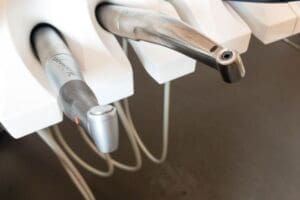Dental cleaning is an essential aspect of maintaining oral hygiene and preventing dental diseases. Professional dental cleanings involve a range of techniques and tools designed to remove plaque, tartar, and stains from teeth, as well as address gum health issues. This article explores the various tools and methods used by professionals during dental cleaning procedures, including routine and deep cleanings, and highlights the impact of innovative technologies on enhancing dental hygiene practices.
Key Takeaways
- Professional dental cleanings are categorized into routine cleaning, which focuses on tooth surfaces and gum line, and deep cleaning, including scaling and root planing, which targets plaque and tartar below the gum line.
- Innovative dental tools, such as ultrasonic scalers and full mouth debridement instruments, have revolutionized dental hygiene practices, allowing for more thorough and efficient cleanings.
- Personalized oral hygiene guidance, empowered by professional advice on the use of dental cleaning tools and techniques, is crucial for patients to maintain optimal oral health between professional cleanings.
Understanding Professional Dental Cleaning
Routine Cleaning vs. Deep Cleaning
When you visit your dentist, you may be presented with different options for maintaining your oral health. Routine cleanings are typically performed to preserve the health of your teeth and gums, focusing on the surfaces of your teeth and along the gum line. These are generally recommended twice a year for individuals with good oral health.
In contrast, deep cleanings, which include procedures like scaling and root planing, target the area below the gum line. This is essential for removing plaque and tartar buildup that can lead to gum disease. If you are diagnosed with gum disease, your dentist may suggest deep cleanings more frequently, perhaps every three to four months, to manage the condition and prevent further complications.
The tools and techniques employed in deep cleanings are specialized to ensure the thorough removal of harmful bacteria and are distinct from those used in routine cleanings. Dental services offered include scaling and root planing, which are integral to the deep cleaning process.
Scaling and Root Planing: The Deep Cleaning Process
Scaling and root planing, often referred to as deep teeth cleaning, is a meticulous procedure aimed at eradicating plaque and tartar from beneath the gum line. This intensive cleaning is crucial for tackling gum disease and ensuring the longevity of your oral health. During the scaling phase, specialized instruments are employed to meticulously remove these harmful deposits.
Following scaling, the process of root planing begins. This involves smoothing the root surfaces to prevent future accumulation of plaque. Such attention to detail is essential for fostering gum recovery and thwarting the progression of gum disease. After the procedure, it is imperative to adhere to specific aftercare instructions to facilitate healing and maintain hygiene. These instructions typically include consuming a soft diet, practicing gentle oral care, and using a mild antibacterial mouth rinse.
It is important to note that the tools and techniques used in deep cleaning are distinct from those in routine cleaning. While routine cleaning addresses the tooth surfaces and gum line, deep cleaning delves deeper to ensure a comprehensive removal of bacteria and tartar, which is pivotal for patients experiencing signs of gum disease.
The Role of Antibiotic Therapy in Dental Cleanings
In the realm of professional dental care, antibiotic therapy plays a pivotal role, particularly when combating persistent infections that routine cleaning cannot address. Topical or oral antibiotics are often employed in conjunction with other treatments to eradicate harmful bacteria, fostering gum healing and enhancing overall periodontal health.
The application of antibiotics is typically a targeted approach, aiming to reduce bacterial presence within periodontal pockets. This strategy is crucial for patients with advanced periodontal disease, where non-surgical options may no longer suffice. In such cases, antibiotic therapy serves as a supportive measure to:
- Alleviate inflammation
- Minimize bacterial colonization
- Promote tissue regeneration
It is essential to understand that antibiotic therapy is not a standalone solution but a complementary one. It is most effective when integrated into a comprehensive treatment plan that may include scaling and root planing, and, if necessary, periodontal pocket reduction surgery. The ultimate goal is to restore and maintain your oral health, ensuring a clean and resilient environment less susceptible to future plaque buildup.
Innovative Tools Enhancing Dental Hygiene Practices
The Impact of New Technology on Teeth Cleaning
The landscape of dental hygiene is undergoing a significant transformation, thanks to the introduction of new technologies. Innovations such as ultrasonic scaling and laser-assisted deep cleaning are revolutionizing the way dental professionals approach teeth cleaning. These advanced techniques offer a gentler, yet highly effective means of removing plaque and tartar, even from below the gum line.
The integration of artificial intelligence and 3D printing into dental practices is not only enhancing the design and creation of dental products but also refining hygiene processes. This technological leap forward is making preventative dental care more affordable and accessible, encouraging patients to take their oral health more seriously.
Here are some of the key advancements enhancing dental hygiene:
- Anti-fog, self-cleaning dental mirrors that provide a clearer view during procedures.
- Desensitizers and other products that make dental visits less invasive and more comfortable.
- Jaw support add-ons that improve patient comfort and accessibility during treatments.
As these tools become more prevalent, dental hygienists are empowered to deliver improved patient outcomes, ensuring a higher standard of oral health care.
Full Mouth Debridement: Techniques and Tools
Full mouth debridement is a comprehensive procedure recommended when a regular cleaning is not sufficient due to the extensive presence of tartar and plaque. This technique is particularly beneficial for individuals who have not had professional dental cleanings in an extended period or exhibit significant plaque buildup.
The process involves the meticulous removal of plaque and tartar from the teeth and gums. It is a more intensive cleaning that targets areas a routine cleaning might miss, ensuring a thorough cleanse. The following are the steps typically involved in full mouth debridement:
- The initial assessment of the oral cavity to determine the extent of plaque and tartar accumulation.
- The use of specialized instruments, such as ultrasonic scalers and hand tools, to remove the hard deposits.
- A careful examination to ensure all surfaces are clean, including those beneath the gum line and between teeth.
After the procedure, your dental professional may provide personalized guidance on maintaining oral hygiene, including the correct use of dental floss, interdental brushes, and brushing techniques. This tailored advice aims to empower you to effectively manage your oral health and prevent future dental issues.
Empowering Patients with Personalized Oral Hygiene Guidance
In the journey to maintain optimal oral health, personalized oral hygiene guidance stands as a cornerstone of patient empowerment. Dental professionals play a crucial role in this educational process, providing tailored advice that aligns with each patient’s unique dental profile.
During your visits, you can expect to receive comprehensive instructions on the most effective techniques for brushing and flossing. This includes:
- The selection of suitable dental cleaning tools tailored to your needs
- Demonstrations of proper brushing techniques to ensure thorough cleaning
- Guidance on the correct use of dental floss and interdental brushes to reach areas between teeth
By embracing a personalized approach, dental hygienists equip you with the knowledge necessary to maintain your oral hygiene effectively between visits. The use of advanced products, such as desensitizers, further enhances the patient experience, making dental visits less daunting and more conducive to regular care. As new technologies emerge, such as artificial intelligence and 3D printing, they promise to revolutionize dental hygiene practices, offering even more precise and patient-friendly solutions.
Conclusion
In summary, professional dental cleaning is an essential component of maintaining optimal oral health. Techniques such as scaling, root planing, and the use of ultrasonic scalers are integral to removing plaque and tartar, especially in areas that regular home care cannot reach. Regular and deep cleanings, each with their specific tools and methods, cater to varying needs, from routine maintenance to addressing periodontal disease. The advancements in dental tools not only enhance the effectiveness of cleanings but also contribute to the overall patient experience. By understanding the importance and benefits of these professional dental cleaning techniques, individuals can take proactive steps towards preserving their dental health and preventing future oral issues.











